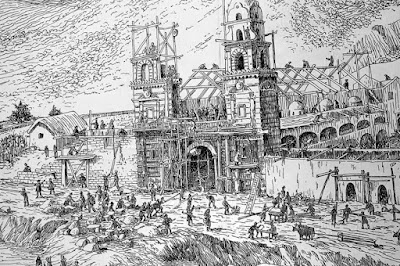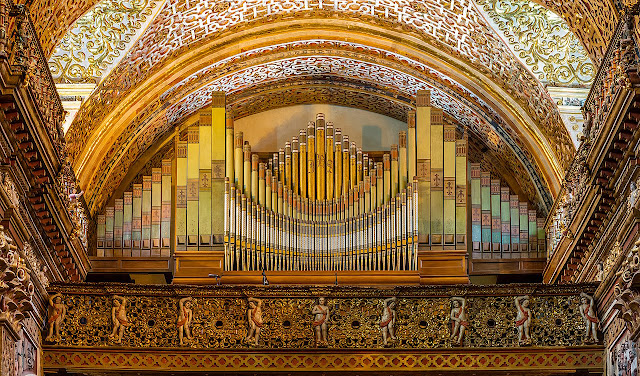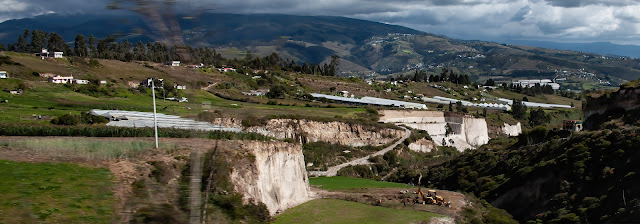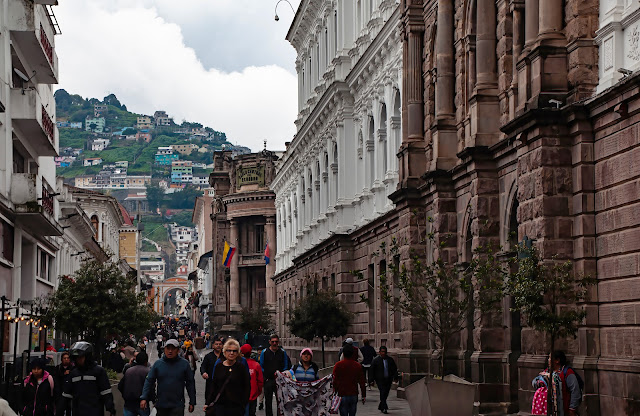We did not follow the Gate 1 itinerary, but we eventually did almost everything (but not all!) listed. This is the part of the trip that I would change if I were managing the tour.
First, though, a caveat: While there have been some cities I have loved visiting (Oslo, Edinburgh, Paris, Segovia), Scott and I are not really city people and, so, unless there is something spectacular to see, I would just as soon go to the mountains or the forest.
 |
| The Spanish influence makes Quito similar to some European cities |
On this trip, the cities seemed a bit forced, as if we had to visit because that’s what you do even though there isn’t that much to see.
 |
| Pretty, but not enough |
Simultaneously, I feel that we spent too little time in the Andes where Quito is located. More on that later.
Quito Overview
But, let’s talk a little about Quito, which at over 9,000 feet above sea level, is the second-highest capital city in the world after La Paz, Bolivia. Wilson was concerned that we would have issues with altitude. Oddly, even though we had been at sea level for almost a week, I didn’t even notice how high we were.
 |
| Quito is right in the Andes |
It is located in a valley on the eastern slopes of Pichincha, an active Andean stratovolcano. I knew this before we arrived. What I didn’t expect was how mountainous the actual city is. It is gorgeous, with mountain peaks, winding roads and a deep rift running right through town.
Unfortunately, we saw all this beauty from the planes we took in and out of the city and the bus we drove through it. I would have loved to stop at an overlook. But, alas, we did not.
Because of its altitude, Quito is cooler that the places we had been so far. It tends to be foggy and rainy, but we did see some blue skies and sunshine. It also receives some of the greatest solar radiation in the world, sometimes reaching a UV Index of 24 by solar noon (0-2 is safe).
Quito is the capital city closest to the Equator, with its northern limits ending about less than a mile south of the line. Quito is also the only capital city that developed so close to an active volcano.
 |
| Right on the flanks; Photo:FourSquare.com |
Pichincha volcano has several summits, among them Ruku Pichincha at 15,400 feet and Guagua Pichincha at 15,728 feet. Its largest eruption occurred in 1660 when almost 10 inches of ash covered the city. There were three minor eruptions in the 19th century. The latest eruption was recorded in 1999, when a few puffs of smoke were seen and ash was deposited on the city. In 2002, another nearby volcano, Reventador, erupted and showered the city in fine ash particles. The same volcano erupted in 2020.
 |
| Reventador, 2020; Photo: Reuters |
Indeed, while we didn’t see it, Wilson took a photo of a volcanic plume on our last day in Quito as he was returning from accompanying Kathy and Fran to the airport for an early morning flight.
 |
| Cotopaxi, 2015; Photo: Reuters |
The oldest traces of human presence in Quito were hunter-gatherer tools of obsidian glass, dated to 8000 BCE. The date of its first habitation is unknown, but archaeological evidence suggests that it was between 4400 and 1600 BCE. A prehistoric village northwest of Quito, dated around 1500 BCE, included rectangular houses and burials with pottery and stone offerings. The inhabitants extracted and exported obsidian to La Costa.
The Quitu Kingdom ruled until the Inca took over the territory in the late 15th century. The area was the capital of the Inca Empire's northern region. Even with all this history, the Spanish conquest of the city in 1534 is the date most frequently cited as the city's “official” founding. Even with this delayed acknowledgement, Quito os the oldest capital in South America.
 |
| It's ridiculous to say the Spanish "founded" Quito; Illustration; Saga TeVé |
In 1563, Quito became the seat of a Real Audiencia (administrative district) of Spain, being part of the Viceroyalty of Peru until 1717, after which it was part of the new Viceroyalty of Nueva Granada.
During the colonial period, more than 20 Roman Catholic churches and convents were built.
 |
| Art from Basilica of San Francisco |
In 1743, after nearly 210 years of Spanish colonization, Quito had about 10,000 inhabitants. Quito briefly proclaimed independence from Spain between 1765 and 1766 during the Quito Revolt, but failed to sustain it. In 1809, another movement was started in Quito to win independence, but it was quashed by colonial troops from Peru.
A chain of conflicts climaxed in 1822, when Antonio José de Sucre, under the command of Simón Bolívar, led troops into the Battle of Pichincha, on the slopes of the volcano. Their victory established the independence of Quito and the surrounding areas.
 |
| Battle of Ibarra; Source: lhistoria: lhistoria |
Independence didn’t bring peace, with multiple uprisings and political assassinations over the next 100+ years. In other words, typical Latin American politics. There is still unrest; we saw protests while on our walking tour.
The top major industries in Quito include petrochemicals, textiles, metals and agriculture, with major crops for export being coffee, sugar, cacao, rice, bananas and palm oil. The city seems more affluent than Guayaquil with a bustling central city.
Quito has the largest, least-altered and best-preserved historic center in the Americas. It was, together with the historic center of Kraków, Poland, the first to be declared a World Heritage Site by UNESCO in 1978. The historic center is south of the capital's current center and is one of the most important historic areas in Latin America.
We took a brief tour of the city the morning after we arrived. I am a bit fuzzy on the order and the places we went, I think it was because I was coming down with a cold. It started with a little cough in Galápagos that I thought was an allergy to one of the plants growing near our cabin. My head wasn’t stuffy; it was just a little cough. That just kept getting worse.
 |
| Our group; Photo: Scott Stevens |
I think my confusion was increased because we had stayed at the EuroBuilding Hotel by the airport and drove into town for our tour.
 |
| It's a pretty big city |
By the way: the hotel was nice and the dinner we had may have been the best of the tour.
The next morning, we had a city tour and then, in the afternoon, we left the city. We moved from place to place in our bus and I never got a real feeling for exactly where we were.
Plus, I got confused about the names of the churches we. It took me a little while after I got home to sort it out.
The Big Statue
The city is dominated by a huge statue called the Virgin of El Panecillo, a 135-foot-tall replica of the 48-inch-tall wooden sculpture created by Bernardo de Legarda in 1734 called the Virgin of Quito. The hill it stands on 656 feet high, making it the highest statue in Ecuador and one of the highest in South America. It is actually taller than the Christ the Redeemer statue in Rio de Janeiro.
 |
| Way up on the hill and up close |
Designed by the Spanish sculptor Agustín de la Herrán Matorras, the statue is made from 7,400 pieces of aluminum, with each piece clearly numbered. After being assembled in Spain, it was disassembled, shipped to Ecuador and assembled again on top of the base. The statue was finished in 1975. It is the tallest aluminum statue in the world.
 |
| Photo: Not Your Average American |
Basilica del Voto Nacional
Our first official stop was the Basilica del Voto Nacional – well, actually, in front of Basilica del Voto Nacional. We did not go inside because, according to Wilson, it isn’t really very interesting inside.
 |
| Side view |
Once the largest churches in the New World, Basilica del Voto Nacional (Basilica of the National Vow) is considered the most important neo-Gothic building in Ecuador, and one of the most representative of the American continent.
 |
| Front view |
 |
| Condor statue |
Although construction began in 1887, the Basilica remains technically "unfinished" because local legend says that when it is completed, the end of the world will come. Well, okay!
The church was directly funded through government allocations until 1895, when the state established a tax on salt to continue building.
The first mass and the first ringing of the bells took place in 1924.
It was consecrated and inaugurated 101 years after building began in 1988. The Roman Catholic Church sure moves glacially.
The building is 460 feet long and 115 feet wide, with two ornate towers reaching a height of 377 feet.
The coolest thing about the building requires one to look closely: the gargoyles represent indigenous animals of Ecuador, including stone Iguanas, Tortoises, Armadillos and Condors.
We stood in front of the building while Wilson gave us a little background and then we spent (in my opinion) way too long with several local women in traditional garb selling shawls and local art. Obviously, their presence was pre-arranged and Wilson did spend some time explaining the different ways shawls are worn. The shawls/scarves were pretty and very inexpensive, so I actually bought two. But, I felt like we just spent too long standing there.
 |
| CW: Vendor; Painting, Kathy modeling a shawl; Shawls I bought: Left Photo: Jenny Owen |
Basilica and Convent of San Francisco
Our next stop was another church, this one quite impressive: the Basilica and Convent of San Francisco, the oldest religious site in Ecuador.
 |
| A beautiful building |
It has 13 cloisters, three temples, a large atrium, more than 3,500 works of colonial art and a Franciscan library.
 |
| Early construction; Source: Casa Gangotena |
The San Francisco church had a fast start and slow finish. It was the first church built in Quito. Construction began in 1535, just a month after the Spanish arrived.
They just had to build Catholic churches everywhere they went!
But, still, it took more than 100 years to finish it.
The inside is staggering – which I think was the point when trying to convert a native population. Everything is gilded – allegedly with 3.5 tons of 18-karat gold.
 |
| It may be the most ornate building I have ever seen |
It is certainly over-the-top.
 |
| Parts of the pipe organ even appear gilded |
While it is impressive, it is also sad because the Spanish used gold they confiscated and native peoples they enslaved to build it so that they could promote a religion that they were forcing upon the people they had conquered and enslaved.
The dome, which is painted like the sky, can be viewed by looking up, or by looking into a wide mirror that is placed directly below. I think this was done after too many people fell over trying to take selfies.
 |
| The ceiling and the dome |
As with all churches, the interior is full of naves, many with statues.
At first, I was amazed at how realistic some of the robes and veils on the statues were until I figured out that they weren’t realistic; they were real. I am not sure I have even seen statues wearing actual clothing before.
 |
| A real veil on the left; a velvet gown on the right |
The Plaza the Basilica faces is distinctly sloped. For several hundred years, it was assumed that it followed the shape of the earth. However, a group of archaeologists recently discovered that San Francisco was built over an Inca temple, which is the reason the actual church is much higher than other structures in Quito.
 |
| The Casa Gangotena Hotel shows the slope of the plaza |
 |
| The steps; Photo: Scott Stevens |
The stairs up to the church are extra deep.
Allegedly, the architects designed them that way so that people approaching the church, had to keep their eyes on their feet to watch where they were going, forcing them to bow their heads in respect.
As with all major Quito buildings, the San Francisco building has undergone multiple renovations, often to fix earthquake damage.
 |
| They did use sturdy materials |
For years, the Plaza de San Francisco supplied the city with water from its central fountain and functioned as a market and social meeting place.
 |
| The fountain |
Before that, the grounds were occupied by the royal palace of the Inca King Huayna Cápac. Archaeological studies between 1983 and 1990 found important ceramic pieces from pre-Columbian cultures under the nave, the cloisters, the orchard, the atrium and the square.
 |
| Huayna Cápac |
Church of La Compañía de Jesús
The final church we visited was the Church of La Compañía de Jesús (The Company of Jesus).
 |
| Again, an ornate gilded interior |
Photography is not allowed, but Wilson took a few shots while pretending to be examining my camera.
Those of us who are not Catholic tend to think of the church as one entity, but there are actually many factions within the church, often vying with each other.
The building of La Compañía underscores that.
Jesuits arrived in Quito in 1586 intent on establishing a church, college and monastery.
When they arrived, they found that most of the land allotted to the Catholic church had already been assigned to Franciscans, Mercedarians, Augustinians and Dominicans. So, they had to cobble together some less-desirable land that was bisected by a ravine. They built brick arches over it and proceeded with construction, which began in 1605.
 |
| External detail |
In 1622, the Jesuits opened the University of San Gregorio in a building attached to the church. The University has moved, but is still operating. The University building now houses Quito's Metropolitan Cultural Center.
With multiple designers and many, many years of construction, the church ended up with four different architectural styles: Mudéjar, Churrigueresque, Neoclassical and Baroque, with Baroque predominating.
 |
| An amazing ceiling |
Building highlights include rich internal ornamentation completely covered with gold sheets, windows that illuminate the entire church with sunlight, domes, barrel vaults, flying buttresses, pillars, fretwork and carvings of native flora and symbols of the ancestral peoples of Ecuador. The church houses life-sized statues of saints, paintings, intricately carved pulpits and lots and lots of sculptures.
 |
| The 1,104-tube pipe organ; Photo: Wikimedia Commons |
The church originally had a bell tower that collapsed after the earthquake of 1859. Although it was replaced, another earthquake nine years later damaged it so much that the tower had to be lowered.
Just like with other churches, locals were forced into slavery to build the churches and animosity still remains. The building across the street from La Compañía had a façade adorned with a row of innocent-looking cherubs facing the church. The people building that wall expressed their viewpoint in one of the cherubs.
 |
| Definitely a statement |
Our itinerary said that we were going to visit the Metropolitan Cultural Center, a museum highlighting Ecuadorian culture and history. But we didn’t. And, although we didn’t visit the Metropolitan Cathedral, we could see it beautiful white belltower and tiled domes.
 |
| A little bit creepy |
We did stop briefly in an old building across the street from La Compañía.
It had thick walls with some of the original beams and wood from the 1500s.
Most interesting, however, was the bones (animal, I hope) embedded in the floor and walls. Wilson said that was done frequently in buildings of the time.
Plaza Grande
Our final stop of our morning tour was Plaza Grande Monumento a los Héroes del 10 de Agosto 5.
 |
| Flowering trees and fountains |
This lovely park commemorates the so-called “first cry” for independence from Spain (an attempt that failed, but started the movement). The Plaza is across the street from the Palace of Carondelet, seat of the Ecuadorian government, where a peaceful protest was going on (I think it got a little unpeaceful a few days later).
The centerpiece of the park is a monument that features a 57-foot-tall column oriented towards the northeast, where every morning the sun rises behind the thousand-year-old hill of Itchimbía. It is topped with a sculpture of the Lady of Independence.
 |
| She is a warrior who symbolizes the idea that freedom is conquered with weapons |
The monument sits on an octagonal stone platform that is surrounded by eight spheres that represent the world, linked together by heavy iron chains.
 |
| The base with its orbs; Photo: Scott Stevens |
But, it’s the lower part of the monument that is more interesting. A triumphant Condor – representing Ecuador – stretches its wings and holds a broken chain in its beak and talons.
 |
| Breaking the chain of enslavement |
Below, a wounded Lion, representing Spain, reluctantly slinks away, trailing banners, a cannon, three rifles and a cross, representing the defeated power of the Hispanic Monarchy. The cross is the sign of Catholicism imposed by Spain.
 |
| It’s pretty powerful monument |
 |
| The sky was darkening with impending rain |
After this brief tour, we had lunch on our own.
Wilson pointed out several restaurants and most of us ate at Hasta la Vuelta, Señor, which means “Until the Return, Lord.” Interesting!
I tried locro de papa (the traditional Ecuadorian potato and cheese soup I talked about in my Ecuador overview). It was DE LISH. We also had some empanadas, which were good but not as good as the ones we had in Galápagos.
 |
| A great lunch; Lower right photo: Jenny Owen |
I feel like I may be giving Quito short shrift. It is a pretty city, but I think the key is to see a lot or none. This seemed both too short, because I couldn’t really grasp the city, and too long because I really wanted to get up in the high mountains. At least we were coming back at the end of the trip.
 |
| A pretty city; Photo: Scott Stevens |
Trip date: March 7 - 19, 2023












No comments:
Post a Comment